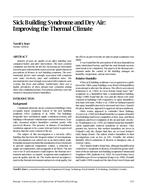Description
Reports of poor air quality in an office building were compared before and after intervention. The most common complaint was that the air felt dry. Increasing air movements in rooms gave improvements in perceived air quality but not in perceptions of dryness or sick building symptoms. The environmental factors most strongly associated with symptoms were static electricity, dust, and ventilation noise. The personal factors most strongly associated with symptoms were eczema, hay fever, and asthma. Furthermore, there was a higher prevalence of these allergic-type symptoms among those who complained of dust. Perceptions of dryness were not related to measured relative humidities.
Paper from IAQ 1997 — Design, Construction, and Operation of Healthy Buildings: Solutions to Global and Regional Concerns
Citation: IAQ Conference: IAQ 97
Product Details
- Published:
- 1997
- Number of Pages:
- 13
- File Size:
- 1 file , 320 KB
- Product Code(s):
- D-25151




